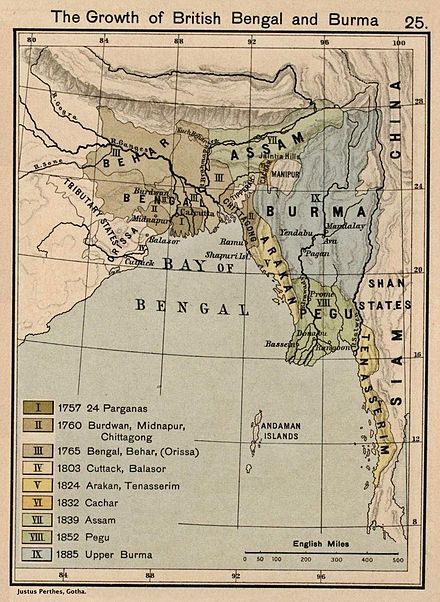Northeast India, officially the North Eastern Region (NER), is the easternmost region of India representing both a geographic and political administrative division of the country.[18] It comprises eight states—Arunachal Pradesh, Assam, Manipur, Meghalaya, Mizoram, Nagaland and Tripura (commonly known as the "Seven Sisters"), and the "brother" state of Sikkim.[19]
The region shares an international border of 5,182 kilometres (3,220 mi) (about 99 per cent of its total geographical boundary) with several neighbouring countries – 1,395 kilometres (867 mi) with China in the north, 1,640 kilometres (1,020 mi) with Myanmar in the east, 1,596 kilometres (992 mi) with Bangladesh in the south-west, 97 kilometres (60 mi) with Nepal in the west, and 455 kilometres (283 mi) with Bhutan in the north-west.[20] It comprises an area of 262,184 square kilometres (101,230 sq mi), almost 8 per cent of that of India. The Siliguri Corridor connects the region to the rest of mainland India.
The states of North Eastern Region are officially recognised under the North Eastern Council (NEC),[19] constituted in 1971 as the acting agency for the development of the north eastern states. Long after induction of NEC, Sikkim formed part of the North Eastern Region as the eighth state in 2002.[21][22] India's Look-East connectivity projects connect Northeast India to East Asia and ASEAN. The city of Guwahati in Assam is referred to as the "Gateway to the Northeast" and is the largest metropolis in Northeast India.


The earliest settlers may have been Austroasiatic speakers from Southeast Asia, followed by Tibeto-Burman speakers from China, and by 500 BCE Indo-Aryan speakers from the Gangetic Plains as well as Kra–Dai speakers from southern Yunnan and Shan State.[23] Due to the biodiversity and crop diversity of the region, archaeological researchers believe that early settlers of Northeast India had domesticated several important plants.[24] Historians believe that the 100 BCE writings of Chinese explorer Zhang Qian indicate an early trade route via Northeast India.[25] The Periplus of the Erythraean Sea mentions a people called Sêsatai in the region,[26] who produced malabathron (cinnamon-like aromatic leaves, dried and used as a flavouring agent), so prized in the old world.[27] Ptolemy's Geographia (2nd century CE) calls the region Kirrhadia, apparently after the Kirata population.[28]
In the early historical period (most of the first millennium CE), Kamarupa straddled most of present-day Northeast India. Xuanzang, a travelling Chinese Buddhist monk, visited Kamarupa in the 7th century CE. He described the people as "short in stature and black-looking", whose speech differed a little from mid-India and who were of simple but violent disposition. He wrote that the people in Kamarupa knew of Sichuan, which lay to the kingdom's east beyond a treacherous mountain.[29]
The northeastern states were established during the British Raj of the 19th and early 20th centuries, when they became relatively isolated from traditional trading partners such as Bhutan and Myanmar.[30] Many of the peoples in present-day Mizoram, Meghalaya and Nagaland converted to Christianity under the influence of British (Welsh) missionaries.[31]
Since the Moamoria disturbances, the Ahom dynasty was on the decline. The British appeared on the scene in the guise of saviours.[32] In the early 19th century, both the Ahom and the Manipur kingdoms fell to a Burmese invasion.[32] The ensuing First Anglo-Burmese War resulted in the entire region coming under British control. In the colonial period (1826–1947), North East India was made a part of Bengal Province from 1839 to 1873, after which Colonial Assam became its own province,[33] but which included Sylhet.
After Indian Independence from British Rule in 1947, the Northeastern region of British India consisted of Assam and the princely states of Tripura Kingdom and Manipur Kingdom. Subsequently, Manipur and Tripura were made Union Territories of India in 1956 and in 1972 attained fully-fledged statehood. Later, Nagaland attained statehood in 1963, Meghalaya in 1972.